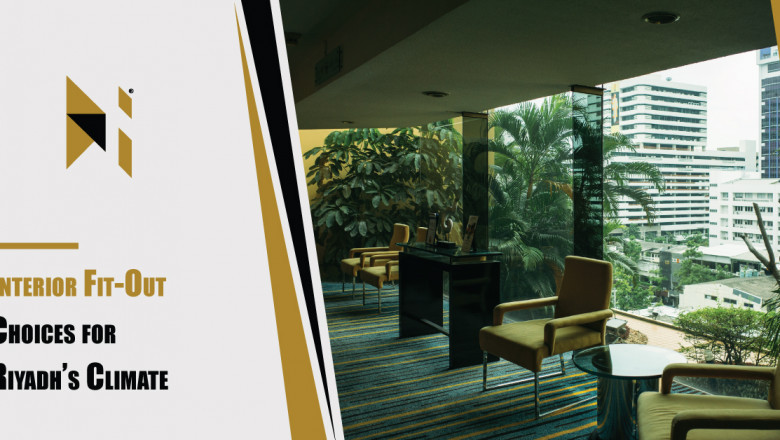views
Riyadh experiences one of the harshest climates in the region—characterized by scorching summers, low humidity, and intense solar radiation. These environmental factors place unique demands on the interior design and fit-out of buildings. A well-thought-out interior fit-out not only enhances comfort but also contributes significantly to energy efficiency and long-term durability in such a climate.
Importance of Heat-Resistant Materials
In Riyadh’s extreme heat, materials used in interior spaces must be chosen for their thermal performance. Traditional choices like untreated wood or plastic may degrade quickly. Instead, materials that reflect heat or provide natural insulation—such as stone, treated wood, and engineered laminates—are preferred. These surfaces help regulate internal temperatures and reduce reliance on air conditioning.
Insulation as a Core Element
Proper insulation is essential for maintaining comfortable indoor environments. Thermal insulation in walls, ceilings, and floors plays a crucial role in keeping the heat out and the cool air in. Interior fit-out solutions should include high-grade insulating materials like mineral wool, polyurethane foam, or high-performance drywall panels. These choices not only provide climate control but also support acoustic comfort.
Color Schemes That Cool
Color isn’t just about aesthetics—it can influence thermal performance too. Light-colored finishes and reflective surfaces help deflect solar radiation, minimizing heat absorption. Whites, creams, beiges, and soft greys on walls, ceilings, and flooring surfaces can help maintain a cooler interior temperature. Additionally, gloss and semi-gloss finishes can further enhance reflectivity.
Smart Shading Solutions
Windows and glass partitions are often heat traps if not treated correctly. For interior fit-outs, incorporating smart shading solutions such as motorized blinds, UV-reflective films, or double-glazed partitions can significantly cut down solar heat gain. Integrating natural light while managing glare and heat is a balancing act best achieved with smart materials and automated shading systems.
Flooring That Fights the Heat
Flooring should be durable, low-maintenance, and resistant to temperature fluctuations. In Riyadh, ceramic and porcelain tiles are popular due to their natural cooling properties. For spaces requiring a warmer or more luxurious look, engineered wood or thermally treated vinyl can be ideal. These materials offer resilience under high temperatures without warping or fading.
Efficient HVAC Integration
Interior fit-outs must consider seamless HVAC (Heating, Ventilation, and Air Conditioning) integration. Proper duct placement, concealed vents, and climate-sensitive zoning can improve the efficiency of cooling systems. Fit-out plans should accommodate modern HVAC designs, ensuring they are both functional and visually appealing.
Maximizing Energy Efficiency with Smart Systems
Smart interior design choices go hand-in-hand with technology. Automated lighting, smart thermostats, and occupancy sensors can significantly reduce energy consumption. When incorporated into fit-out projects, these systems allow for real-time adjustments based on indoor temperatures and usage patterns—ensuring comfort without wasting energy.
Sustainable Finishes and Eco-Friendly Solutions
Sustainability should be a central focus in any modern interior project, especially in climates that already strain resources. Fit-out choices should include non-toxic paints, locally sourced materials, and certified green products that minimize environmental impact. This approach not only supports eco-conscious living but also aligns with growing global sustainability goals.
Custom Furniture and Layout Planning
Interior layouts should be designed to promote airflow and avoid cluttered spaces that trap heat. Custom furniture can be built with breathable materials and arranged to allow air to circulate freely. High-back chairs and padded seats with breathable fabrics help prevent overheating, adding both comfort and practicality.
Fit-Outs for Commercial Spaces in Riyadh
Commercial interiors in Riyadh, such as offices, retail stores, and hospitality venues, require robust and adaptable fit-out strategies. High footfall and long operating hours make it essential to use durable finishes and climate-tolerant lighting. Commercial fit-outs should also prioritize customer comfort, integrating shaded areas, soft lighting, and cooling zones throughout the premises.
Residential Fit-Out Best Practices
For homes, personal comfort and energy conservation take priority. Interior designers often work closely with homeowners to create layouts that facilitate cross-ventilation, minimize sun exposure, and maintain aesthetic value. Using multifunctional furniture and modular design elements ensures flexibility and performance without compromising on style.
Role of Local Expertise in Fit-Out Success
Partnering with a local fit-out specialist who understands Riyadh’s climate is crucial. They can recommend materials and designs that have been tested in local conditions and are readily available. Local knowledge also aids in navigating compliance standards, ensuring each project meets regulatory and safety requirements.
Future Trends in Riyadh’s Interior Design
With the rapid development in Riyadh, the future of interior fit-outs is leaning towards innovation and sustainability. Trends such as biophilic design (which brings elements of nature indoors), energy-positive buildings, and modular, reconfigurable interiors are becoming more prominent. The right fit-out choices today can set the foundation for adaptive, future-ready interiors.
Conclusion: Building Comfort for the Long Term
Riyadh’s climate poses unique challenges, but with smart planning and the right materials, interior spaces can remain comfortable, functional, and energy-efficient. Whether designing a home, office, or commercial space, a climate-conscious fit-out strategy is key. From heat-resistant materials to smart technologies, each decision contributes to long-term comfort and sustainability. Investing in climate-appropriate fit-out solutions ensures that interiors not only endure the heat—but thrive in it.














Comments
0 comment